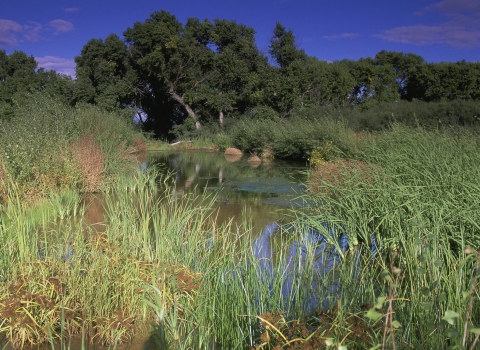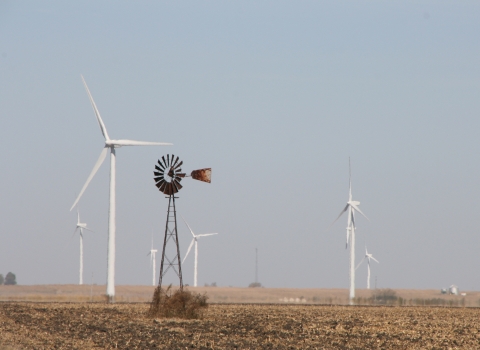*U.S. Fish and Wildlife Service Analysis Does Not Support*
*Proposed Land Exchange and Road Corridor Through*
*Izembek National Wildlife Refuge*
The U.S. Fish and Wildlife Service today released a final Environmental Impact Statement (EIS) evaluating a proposed land exchange that would establish a road corridor through the Izembek National Wildlife Refuge in southwest Alaska. After careful evaluation of the impact of the construction and operation of the proposed road on the refuge and its wildlife resources, the agency has identified its preferred alternative as one that does not support allowing the land exchange to go forward.
“The Fish and Wildlife Service’s preferred alternative would protect the heart of a pristine landscape that congress designated as wilderness and that serves as vital habitat for grizzly bear, caribou and salmon, shorebirds and waterfowl – including 98 percent of the world’s population of Pacific black brant,” said Secretary of the Interior Ken Salazar. “After extensive dialogue and exhaustive scientific evaluation, the agency has identified a preferred path forward that will ensure this extraordinary refuge and its wilderness are conserved and protected for future generations.”
To complete the analysis, as directed by Congress in the Omnibus Public Land Management Act of 2009, the Service conducted a transparent public process that involved all affected parties as cooperators in the EIS. Through more than 100 meetings and many trips to King Cove by Service and Department of the Interior officials, coupled with careful consideration of input from stakeholders, the agency worked diligently to ensure a complete dialogue on and understanding of the issue.
“Our final decision will be based on the analysis contained in this document, which reflects the most current scientific information and the expertise of our biologists,” said Fish and Wildlife Service Director Dan Ashe. “The weight of this scientific evidence demonstrates that building a road through the refuge would irretrievably damage the ecological functions of the refuge and impair its ability to provide vital support for native wildlife.”
Under the provisions of the 2009 Act, the lands transferred to the State under the proposed three-party land exchange would be used to develop a road corridor through the refuge to connect the communities of Cold Bay and King Cove, Alaska. As directed by Congress, the EIS analyzed the environmental impacts of the potential construction and operation of such a road corridor, in addition to the impacts of the land exchange itself.
In response to the 2009 Act, the Service analyzed five alternatives in the EIS: no action, two road alternatives, hovercraft service six days a week, and ferry service. The Service expects to issue a formal Record of Decision no earlier than 30 days after publication of the final EIS.
The proposed road would permanently bisect the area, where most of the refuge’s 315,000 acres are congressionally-designated Wilderness. By designating this area as wilderness, the most protective category of public lands, Congress recognized the need to protect Izembek as a place where natural processes prevail with few signs of human presence.
The permanent road would fragment undisturbed habitat for grizzly bear, caribou and salmon, and would compromise the protections offered to waterfowl and shorebirds. At the heart of the areas protected are internationally significant eelgrass beds in Izembek and Kinzarof lagoons, as well as adjacent uplands of the isthmus. These wetlands, among the first in the U.S. to be designated as a “Wetland of International Importance” in 1987 under the Ramsar Convention, feed more than 98 percent of the world's Pacific black brant before they fly to wintering grounds in Mexico. Other species that depend on these wetlands and eelgrass beds include emperor geese, Steller’s eiders, and hundreds of thousands of other federally-protected waterfowl and shorebirds.
While the proposed land exchange would bring many more acres of land into the Refuge System, the analysis indicates that the increased acreage could not compensate for the unique values of existing refuge lands, nor the anticipated effects that the proposed road would have on wildlife, habitat, subsistence resources, and wilderness values of the refuge. Based on this analysis, the Service has selected Alternative 1, the no action alternative, as the preferred alternative.
“The Izembek Refuge and its Wilderness were established to protect some of the most unique and important wetlands in the world, and running a road through those sensitive areas will have lasting consequences for Alaska’s wildlife,” said Geoff Haskett, the Service’s Alaska Regional Director. “We will continue to work with the State of Alaska and local communities to support viable alternatives to ensure the continued health and safety of King Cove residents.”
The idea of a road connecting King Cove and Cold Bay has been discussed since the 1990s. The late Alaska Sen. Ted Stevens spearheaded an effort in 1997 that led Congress to provide over $37 million in federal funding as an alternative to a road through the Izembek Refuge and Izembek Wilderness. The funding upgraded the medical clinic, improved the King Cove airstrip, and created a transportation link between King Cove and Cold Bay via an unpaved road from King Cove to a hovercraft and terminal. During the time that it was in operation from 2007 to 2010, the hovercraft successfully completed every requested medical evacuation.
In November 2010, the Aleutians East Borough decided to suspend hovercraft services between King Cove and Cold Bay. If the proposed road through the refuge is not constructed, the Borough has indicated that it will develop an alternative transportation link between King Cove and Cold Bay. The Borough has indicated that an aluminum landing craft/passenger ferry could be more technically and financially viable than a hovercraft.
A summary of the public comments received and responses to substantive comments are addressed in the final EIS, which is available for public review for at least 30 days. This 30-day review period under the National Environmental Policy Act allows federal and state agencies, and individuals and organizations who commented on the draft document, a chance to review the Service’s response in the final EIS. After the review period ends, the Service will complete the Record of Decision.
A copy of the final EIS is available at: * **http://www.fws.gov/nwrs/threecolumn.aspx?id=2147524796** *or you may request a compact disc of the entire document by email, *izembek_eis@fws.gov*; or telephone, (907) 786-3357. For more information about the refuge, visit *http://izembek.fws.gov*.
Press Release
U.S. Fish and Wildlife Service Analysis Does Not Support Proposed Land Exchange and Road Corridor Through Izembek National Wildlife Refuge

